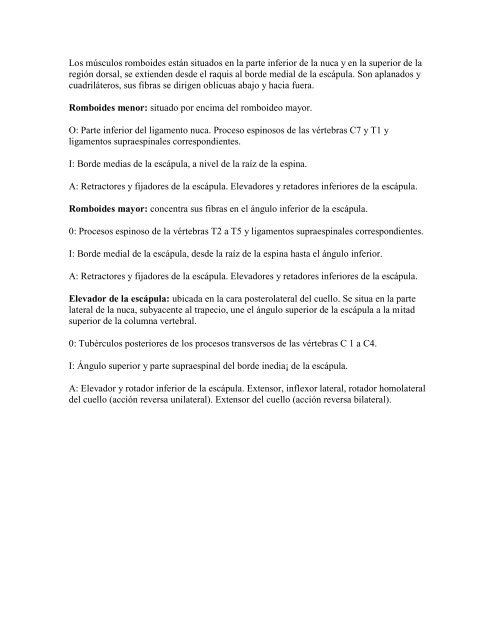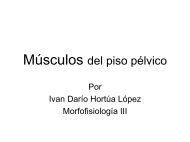EL CORE Anatomía de los músculos de la pared ... - sobre Pilates
EL CORE Anatomía de los músculos de la pared ... - sobre Pilates
EL CORE Anatomía de los músculos de la pared ... - sobre Pilates
You also want an ePaper? Increase the reach of your titles
YUMPU automatically turns print PDFs into web optimized ePapers that Google loves.
Los múscu<strong>los</strong> romboi<strong>de</strong>s están situados en <strong>la</strong> parte inferior <strong>de</strong> <strong>la</strong> nuca y en <strong>la</strong> superior <strong>de</strong> <strong>la</strong><br />
región dorsal, se extien<strong>de</strong>n <strong>de</strong>s<strong>de</strong> el raquis al bor<strong>de</strong> medial <strong>de</strong> <strong>la</strong> escápu<strong>la</strong>. Son ap<strong>la</strong>nados y<br />
cuadriláteros, sus fibras se dirigen oblicuas abajo y hacia fuera.<br />
Romboi<strong>de</strong>s menor: situado por encima <strong>de</strong>l romboi<strong>de</strong>o mayor.<br />
O: Parte inferior <strong>de</strong>l ligamento nuca. Proceso espinosos <strong>de</strong> <strong>la</strong>s vértebras C7 y T1 y<br />
ligamentos supraespinales correspondientes.<br />
I: Bor<strong>de</strong> medias <strong>de</strong> <strong>la</strong> escápu<strong>la</strong>, a nivel <strong>de</strong> <strong>la</strong> raíz <strong>de</strong> <strong>la</strong> espina.<br />
A: Retractores y fijadores <strong>de</strong> <strong>la</strong> escápu<strong>la</strong>. Elevadores y retadores inferiores <strong>de</strong> <strong>la</strong> escápu<strong>la</strong>.<br />
Romboi<strong>de</strong>s mayor: concentra sus fibras en el ángulo inferior <strong>de</strong> <strong>la</strong> escápu<strong>la</strong>.<br />
0: Procesos espinoso <strong>de</strong> <strong>la</strong> vértebras T2 a T5 y ligamentos supraespinales correspondientes.<br />
I: Bor<strong>de</strong> medial <strong>de</strong> <strong>la</strong> escápu<strong>la</strong>, <strong>de</strong>s<strong>de</strong> <strong>la</strong> raíz <strong>de</strong> <strong>la</strong> espina hasta el ángulo inferior.<br />
A: Retractores y fijadores <strong>de</strong> <strong>la</strong> escápu<strong>la</strong>. Elevadores y retadores inferiores <strong>de</strong> <strong>la</strong> escápu<strong>la</strong>.<br />
Elevador <strong>de</strong> <strong>la</strong> escápu<strong>la</strong>: ubicada en <strong>la</strong> cara postero<strong>la</strong>teral <strong>de</strong>l cuello. Se situa en <strong>la</strong> parte<br />
<strong>la</strong>teral <strong>de</strong> <strong>la</strong> nuca, subyacente al trapecio, une el ángulo superior <strong>de</strong> <strong>la</strong> escápu<strong>la</strong> a <strong>la</strong> mitad<br />
superior <strong>de</strong> <strong>la</strong> columna vertebral.<br />
0: Tubércu<strong>los</strong> posteriores <strong>de</strong> <strong>los</strong> procesos transversos <strong>de</strong> <strong>la</strong>s vértebras C 1 a C4.<br />
I: Ángulo superior y parte supraespinal <strong>de</strong>l bor<strong>de</strong> inedia¡ <strong>de</strong> <strong>la</strong> escápu<strong>la</strong>.<br />
A: Elevador y rotador inferior <strong>de</strong> <strong>la</strong> escápu<strong>la</strong>. Extensor, inflexor <strong>la</strong>teral, rotador homo<strong>la</strong>teral<br />
<strong>de</strong>l cuello (acción reversa uni<strong>la</strong>teral). Extensor <strong>de</strong>l cuello (acción reversa bi<strong>la</strong>teral).



